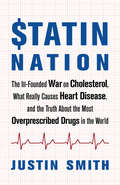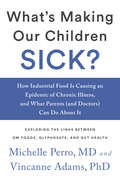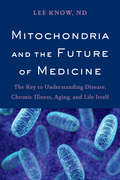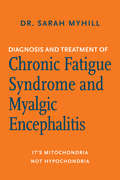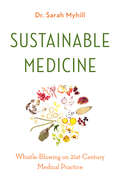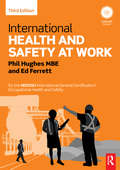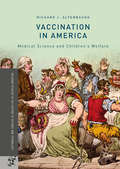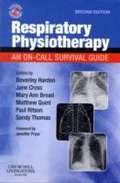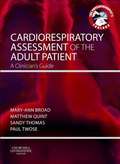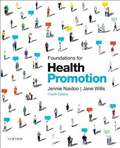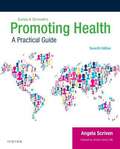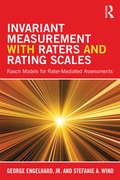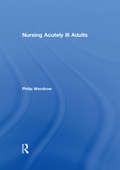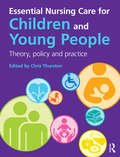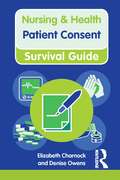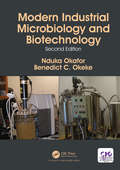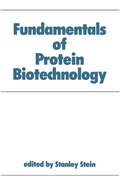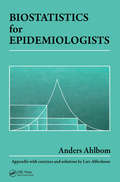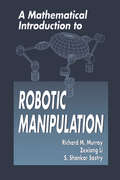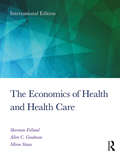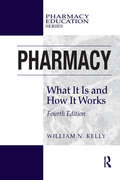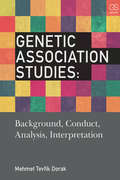- Table View
- List View
Statin Nation: The Ill-Founded War on Cholesterol, What Really Causes Heart Disease, and the Truth About the Most Overprescribed Drugs in the World
by Justin SmithHeart disease is the leading cause of death worldwide, and for decades conventional health authorities have pushed that the culprits are fat and cholesterol clogging up coronary arteries. Consequently, lowering cholesterol has become a hugely lucrative business, and cholesterol-lowering Statin drugs are now the most prescribed medication in the world, with clinical data showing one billion people eligible for prescription. However, these cholesterol guidelines have been heavily criticized, and increasingly, doctors and researchers have been questioning the role cholesterol plays in heart disease. We now know that people with heart disease often do not, in fact, have high cholesterol, and even the strongest supporters of the cholesterol hypothesis now admit that no ideal level of cholesterol can be identified. Large-scale studies have proven that statins are not generating the benefits that were predicted, and new research shows that high cholesterol may actually prevent heart disease. Worse still, millions of people in the United States and worldwide are taking statins preventatively, at great cost to their health. A complete reevaluation of the real causes of heart disease is long overdue, not to mention an inquiry into why the pharmaceutical industry continues to overprescribe statins (and market them aggressively to consumers) despite this evidence. Statin Nation offers a new understanding of heart disease, and Justin Smith forges an innovative path away from the outdated cholesterol myth with a viable alternative model to address the real causes of heart disease. Statin Nation provides detailed examinations of nutritional alternatives that are up to six times more effective than statins, and other interventions that have been shown to be up to eleven times more effective than statins. But all of these methods are currently ignored by health authorities. Smith provides a heart disease prevention plan that anyone can use, providing hope for the future of heart-disease treatment with a purpose.
What's Making Our Children Sick?: How Industrial Food Is Causing an Epidemic of Chronic Illness, and What Parents (and Doctors) Can Do About It
by Vincanne Adams Dr Michelle PerroExploring the links between GM foods, glyphosate, and gut health With chronic disorders among American children reaching epidemic levels, hundreds of thousands of parents are desperately seeking solutions to their children’s declining health, often with little medical guidance from the experts. What’s Making Our Children Sick? convincingly explains how agrochemical industrial production and genetic modification of foods is a culprit in this epidemic. Is it the only culprit? No. Most chronic health disorders have multiple causes and require careful disentanglement and complex treatments. But what if toxicants in our foods are a major culprit, one that, if corrected, could lead to tangible results and increased health? Using patient accounts of their clinical experiences and new medical insights about pathogenesis of chronic pediatric disorders—taking us into gut dysfunction and the microbiome, as well as the politics of food science—this book connects the dots to explain our kids’ ailing health. What’s Making Our Children Sick? explores the frightening links between our efforts to create higher-yield, cost-efficient foods and an explosion of childhood morbidity, but it also offers hope and a path to effecting change. The predicament we now face is simple. Agroindustrial “innovation” in a previous era hoped to prevent the ecosystem disaster of DDT predicted in Rachel Carson’s seminal book in 1962, Silent Spring. However, this industrial agriculture movement has created a worse disaster: a toxic environment and, consequently, a toxic food supply. Pesticide use is at an all-time high, despite the fact that biotechnologies aimed to reduce the need for them in the first place. Today these chemicals find their way into our livestock and food crop industries and ultimately onto our plates. Many of these pesticides are the modern day equivalent of DDT. However, scant research exists on the chemical soup of poisons that our children consume on a daily basis. As our food supply environment reels under the pressures of industrialization via agrochemicals, our kids have become the walking evidence of this failed experiment. What’s Making Our Children Sick? exposes our current predicament and offers insight on the medical responses that are available, both to heal our kids and to reverse the compromised health of our food supply.
Mitochondria and the Future of Medicine: The Key to Understanding Disease, Chronic Illness, Aging, and Life Itself
by Lee KnowWith information for patients and practitioners on optimizing mitochondrial function for greater health and longevity Why do we age? Why does cancer develop? What's the connection between heart failure and Alzheimer's disease, or infertility and hearing loss? Can we extend lifespan, and if so, how? What is the Exercise Paradox? Why do antioxidant supplements sometimes do more harm than good? Many will be amazed to learn that all these questions, and many more, can be answered by a single point of discussion: mitochondria and bioenergetics. In Mitochondria and the Future of Medicine, Naturopathic Doctor Lee Know tells the epic story of mitochondria, the widely misunderstood and often-overlooked powerhouses of our cells. The legendary saga began over two billion years ago, when one bacterium entered another without being digested, which would evolve to create the first mitochondrion. Since then, for life to exist beyond single-celled bacteria, it's the mitochondria that have been responsible for this life-giving energy. By understanding how our mitochondria work, in fact, it is possible to add years to our lives, and life to our years. Current research, however, has revealed a dark side: many seemingly disconnected degenerative diseases have tangled roots in dysfunctional mitochondria. However, modern research has also endowed us with the knowledge on how to optimize its function, which is of critical importance to our health and longevity. Lee Know offers cutting-edge information on supplementation and lifestyle changes for mitochondrial optimization, such as CoQ10, D-Ribose, cannabinoids, and ketogenic dietary therapy, and how to implement their use successfully. Mitochondria and the Future of Medicine is an invaluable resource for practitioners interested in mitochondrial medicine and the true roots of chronic illness and disease, as well as anyone interested in optimizing their health.
Diagnosis and Treatment of Chronic Fatigue Syndrome and Myalgic Encephalitis: It's Mitochondria, Not Hypochondria
by Sarah MyhillMitochondria are the powerhouses of our cells, essential for the production and management of energy at the cell level. Dr. Sarah Myhill has spent years studying the relationship between mitochondrial malfunction and one of the most common problems that leads people to the doctor’s office: fatigue. In Diagnosis and Treatment of Chronic Fatigue Syndrome and Myalgic Encephalitis, Dr. Myhill examines this essential role of our mitochondria in energy production and why it is key to understanding and overcoming Chronic Fatigue Syndrome (CFS) and the inflammation that often accompanies it: Myalgic Encephalitis (ME). She explains the importance of healthy mitochondria, how we can assess how well they are functioning, what we can do to keep them healthy, and how to restore them to health if problems arise. Since publication of the first edition in 2014, new research and new clinical findings have shed further light on a condition that is debilitating to those who suffer from it, but “all in the head” to many doctors. The second edition of this groundbreaking book includes new insights and chapters on why CFS/ME is the most poorly treated condition in Western medicine, the role of the gut, allergy and autoimmunity, Lyme disease and other coinfections, reprogramming the immune system, reprogramming the brain, and the roadmap to recovery.
Sustainable Medicine: Whistle-Blowing on 21st-Century Medical Practice
by Sarah MyhillSustainable Medicine is based on the premise that twenty-first century Western medicine—driven by vested interests—is failing to address the root causes of disease. Symptom-suppressing medication and “polypharmacy” have resulted in an escalation of disease and a system of so-called “health care,” which more closely resembles “disease care.” In this essential book, Dr. Sarah Myhill aims to empower people to heal themselves by addressing the underlying causes of their illness. She presents a logical progression from identifying symptoms, to understanding the underlying mechanisms, to relevant interventions and tests and tools with which to tackle the root causes. As Myhill writes, “It’s all about asking the question ‘why?’” Sustainable Medicine covers a wide range of symptoms including inflammation (infection, allergy, autoimmunity), fatigue, pain, toxic symptoms, deficiency symptoms, and hormonal symptoms. And Dr. Myhill includes a toolbox of treatments for specific illnesses and ailments, as well as a general approach to avoiding and treating all disease. Finally, she offers a series of case histories to show how people have successfully taken control of their health and healed even in the face of the most discouraging symptoms—all without the harmful interventions of 21st century Western medicine.
International Health and Safety at Work: for the NEBOSH International General Certificate in Occupational Health and Safety
by Phil Hughes Ed FerrettInternational Health and Safety at Work has been specially written in simple English for the thousands of students who complete the NEBOSH International General Certificate in Health and Safety each year. Fully revised in alignment with the April 2015 syllabus, this third edition provides students with all they need to tackle the course with confidence. Clear, easily accessible information is presented in full colour, with discussion of essential principles such as ILO and OSH conventions as well as legal frameworks from a range of countries. Aligned to the NEBOSH International General Certificate in Occupational Health and Safety Practice questions and answers to test knowledge and increase understanding Complete with a companion website containing extra resources for tutors and students at www.routledge.com/cw/hughes The only textbook endorsed for the NEBOSH International General Certificate in Health and Safety, International Health and Safety at Work remains the most effective tool for those working to fit international health and safety standards to local needs and practice.
International Health and Safety at Work: for the NEBOSH International General Certificate in Occupational Health and Safety
by Phil Hughes Ed FerrettInternational Health and Safety at Work has been specially written in simple English for the thousands of students who complete the NEBOSH International General Certificate in Health and Safety each year. Fully revised in alignment with the April 2015 syllabus, this third edition provides students with all they need to tackle the course with confidence. Clear, easily accessible information is presented in full colour, with discussion of essential principles such as ILO and OSH conventions as well as legal frameworks from a range of countries. Aligned to the NEBOSH International General Certificate in Occupational Health and Safety Practice questions and answers to test knowledge and increase understanding Complete with a companion website containing extra resources for tutors and students at www.routledge.com/cw/hughes The only textbook endorsed for the NEBOSH International General Certificate in Health and Safety, International Health and Safety at Work remains the most effective tool for those working to fit international health and safety standards to local needs and practice.
Vaccination in America: Medical Science and Children’s Welfare (Palgrave Studies in the History of Science and Technology)
by Richard J. AltenbaughThe success of the polio vaccine was a remarkable breakthrough for medical science, effectively eradicating a dreaded childhood disease. It was also the largest medical experiment to use American schoolchildren. Richard J. Altenbaugh examines an uneasy conundrum in the history of vaccination: even as vaccines greatly mitigate the harm that infectious disease causes children, the process of developing these vaccines put children at great risk as research subjects. In the first half of the twentieth century, in the face of widespread resistance to vaccines, public health officials gradually medicalized American culture through mass media, public health campaigns, and the public education system. Schools supplied tens of thousands of young human subjects to researchers, school buildings became the main dispensaries of the polio antigen, and the mass immunization campaign that followed changed American public health policy in profound ways. Tapping links between bioethics, education, public health, and medical research, this book raises fundamental questions about child welfare and the tension between private and public responsibility that still fuel anxieties around vaccination today.
Vaccination in America: Medical Science and Children’s Welfare (Palgrave Studies in the History of Science and Technology)
by Richard J. AltenbaughThe success of the polio vaccine was a remarkable breakthrough for medical science, effectively eradicating a dreaded childhood disease. It was also the largest medical experiment to use American schoolchildren. Richard J. Altenbaugh examines an uneasy conundrum in the history of vaccination: even as vaccines greatly mitigate the harm that infectious disease causes children, the process of developing these vaccines put children at great risk as research subjects. In the first half of the twentieth century, in the face of widespread resistance to vaccines, public health officials gradually medicalized American culture through mass media, public health campaigns, and the public education system. Schools supplied tens of thousands of young human subjects to researchers, school buildings became the main dispensaries of the polio antigen, and the mass immunization campaign that followed changed American public health policy in profound ways. Tapping links between bioethics, education, public health, and medical research, this book raises fundamental questions about child welfare and the tension between private and public responsibility that still fuel anxieties around vaccination today.
Respiratory Physiotherapy: An On-call Survival Guide (Physiotherapy Pocketbooks Series (PDF))
by Beverley Harden Jane Cross Mary Ann Broad Matthew Quint Paul Ritson Sandy ThomasThe second edition of Respiratory Physiotherapy (formerly Emergency Physiotherapy) continues to be a highly accessible and convenient guide which brings the insight of clinical experts in the field to the fingertips of the busy physiotherapist who are often exposed to challenging and stressful situations. Beverley Harden is now joined by a team of 5 additional Editors and the new edition has been completely revamped. It looks at assessment, management of and calls to specific areas while presenting key information in tables, bullets and summaries for quick reference on the ward. Respiratory Physiotherapy is the essential pocketbook for physiotherapy students on clinical placement, newly qualified physiotherapists, as well as for physiotherapists working in emergency settings who need a refresher. Case studies that cover common emergency situations Self-assessment questions which offer the reader verification of their comprehension and clinical reasoning skills A-Z of treatment techniques Appendices including normal values and common drugs used in critical care areas so that essential information is always at hand.
Cardiorespiratory Assessment Of The Adult Patient: A Clinician's Guide (Physiotherapist's Tool Box Series (PDF))
by Mary Ann Broad Paul Twose Matthew Quint Sandy ThomasThis new innovative resource aims to give physiotherapy students and those new to respiratory care a simple, easy-to-use guide to the process and procedures used in the assessment of adult respiratory patients. Cardiorespiratory Assessment of the Adult Patient begins by identifying the scope of respiratory physiotherapy and listing some key aims of assessment with an overview of different approaches. It then goes on to provide a selection of 'assessment checklists' for the main clinical settings which the physiotherapist is likely to encounter. Chapter 3 provides a selection of 'assessment tools' given alphabetically, including those that physiotherapists may be expected to carry out themselves and those where they only need to interpret the assessment findings. These tools include a systematic guide to the procedure involved (where relevant) and an explanation of the key findings and their significance for the physiotherapist. In the final section, individuals can apply their knowledge using case scenarios and suggested solutions are also provided.
Foundations For Health Promotion (Public Health And Health Promotion Series)
by Jennie Naidoo Jane WillsThe fourth edition of Foundations for Health Promotion continues to offer a wealth of information in a friendly, easy-to-read format. This edition has been comprehensively updated and includes a new feature of learning activities with indicative answers to help students and practitioners to reflect on their practice. 'Pull out' boxes of case studies and examples help the reader to identify the evidence base for health promotion and illustrate the range of health promotion practice. Divided into four parts, the book first explains the theoretical concepts of health, health education and health promotion and the ethical and political aspects of practice. The second part explores strategies to promote health and some of the dilemmas that they pose. The third part explores how a range of different settings, such as hospitals and schools, can be oriented towards positive health and well-being. The fourth part focuses on the implementation of health promotion interventions and is designed to help practitioners to reflect on their practice by examining what drives their choice of strategy. Foundations for Health Promotion, Fourth Edition will be ideal for a range of disciplines including health service professionals in primary and acute settings, those working in local and municipal authorities to promote health and wellbeing, health educators and trainers. Comprehensive updating and expansion to reflect recent research findings and major organizational and policy changes Clear structure and signposting for ease of reading and study Wide choice of examples and illustrative case studies reflect the needs of a variety of professional groups in health services, local and municipal services and education Ineractive learning activities with indicative answers help readers consolidate their learning Comprehensively updated and expanded to reflect major organizational and policy changes Interactive learning activities with indicative answers at the end of each chapter 'Pull out' boxes illustrate recent research findings and case studies of practice
Promoting Health - A Practical Guide: (Ewles And Simnett) (PDF)
by Angela ScrivenRetaining the features that characterized the phenomenal success of previous editions - namely, authority, accessibility and a user-friendly style - the latest edition of Ewles & Simnett's Promoting Health: A Practical Guide, continues to offer readers with a sound introduction to the theory and practice of promoting public health. Organised into three parts, the first section, 'Thinking About Health, Health Promotion and Public Health', explains what health, health promotion, public health and health education entail. The second part, 'Planning and Managing Health Promotion and Public Health Practice' focuses on the health promoter's daily work, beginning with a basic planning and evaluation framework followed by a discussion of how to identify and assess needs and priorities. The final part of the book, 'Competence in Health Promotion and Public Health Practice', examines how readers can develop their competence in carrying out a range of activities, including enabling clients to learn in one-to-one and group settings, working with communities and changing policies and practices. Fully updated throughout by a renowned author, the latest edition of this classic book includes the latest research on the comparative effectiveness of different approaches to health promotion and public health practice, and explores the development of public health communication strategies, including social marketing, social media campaigns, and use of pressure groups and 'nudging'. The book also highlights the latest thinking on a wide variety of topics to ensure relevance to a broad array of practitioners working across differing settings. Richly endowed with a wide range of interactive exercises and helpful case studies, Ewles & Simnett's Promoting Health: A Practical Guide, seventh edition, will be ideal for anyone involved with health promotion and public health wherever they are based.
Invariant Measurement with Raters and Rating Scales: Rasch Models for Rater-Mediated Assessments
by George Engelhard Jr. Stefanie WindThe purpose of this book is to present methods for developing, evaluating and maintaining rater-mediated assessment systems. Rater-mediated assessments involve ratings that are assigned by raters to persons responding to constructed-response items (e.g., written essays and teacher portfolios) and other types of performance assessments. This book addresses the following topics: (1) introduction to the principles of invariant measurement, (2) application of the principles of invariant measurement to rater-mediated assessments, (3) description of the lens model for rater judgments, (4) integration of principles of invariant measurement with the lens model of cognitive processes of raters, (5) illustration of substantive and psychometric issues related to rater-mediated assessments in terms of validity, reliability, and fairness, and (6) discussion of theoretical and practical issues related to rater-mediated assessment systems. Invariant measurement is fast becoming the dominant paradigm for assessment systems around the world, and this book provides an invaluable resource for graduate students, measurement practitioners, substantive theorists in the human sciences, and other individuals interested in invariant measurement when judgments are obtained with rating scales.
Nursing Acutely Ill Adults
by Philip WoodrowThis comprehensive and clinically-focused textbook is designed for student and qualified nurses concerned with caring effectively for deteriorating and acutely ill adults outside of specialist intensive care units. Divided into six sections, the book begins with chapters on assessment and the deteriorating patient, including monitoring vital signs and interpreting blood results. This is followed by two sections focusing on breathing and cardiovascular problems respectively. Section 4 explores issues around disability and impairment, including chapters on neurology, pain management, psychological needs and thermoregulation. The penultimate section looks at maintaining the internal environment, with chapters on issues such as nutrition, fluid management and infection control. The text ends with a discussion of legal issues and accountability. Nursing Acutely Ill Adults includes a full range of pedagogical features, including sections: identifying fundamental knowledge; highlighting implications for practice; giving further reading and resources; using case scenarios to help readers relate theory to practice; and providing ‘time out’ exercises. It is the ideal textbook for students taking modules in caring for critically ill adults and qualified nurses working with these patients.
Essential Nursing Care for Children and Young People: Theory, Policy and Practice
by Chris ThurstonEssential Nursing Care for Children and Young People is the definitive guide for all nursing and healthcare students and professionals caring for children and young people. Designed to meet the 2010 NMC competency standards for pre-registration nurses, the textbook supports you through the process of caring for children and young people with varied needs and conditions across all healthcare settings. A practical, patient-centred approach is taken throughout, with the ‘voices’ of children, their families and their carers used to tie theoretical knowledge to the real experience of providing care. The inclusion of the latest research and health and social care policies ensures that you are fully in line with the latest clinical practice, whilst the book’s activities and exercises allow you to regularly check your understanding and develop confidence during your journey from student to nursing professional. Main features: Course-Focused Approach – pedagogy and content designed specifically for all three years of the child nursing degree programme. Contemporary Content – research note features and policy integrated throughout to give you instant access to the latest evidence-based practice. Illustrated Throughout – this highly accessible text regularly uses pictures and diagrams to highlight key issues. Voices – include authentic experiences of children, young people, parents, carers and professionals to help develop a patient-focused attitude to care. Pertinent A&P – includes coverage of all relevant anatomy and physiology for child and young person nursing courses. Practice Guidelines – provide practical guidance on everyday procedures for your quick reference. Activities and Answers – allow you to check your knowledge and build confidence. Specialist Authors – each chapter is written by leading experts in each area. Essential Nursing Care for Children and Young People is the ideal main textbook for all undergraduate child and young person nursing students, as well as professionals wanting to ensure they are using the latest practice. This text is also relevant to any student or professional involved in the health and social care of children and young adults.
Essential Nursing Care for Children and Young People: Theory, Policy and Practice
by Chris ThurstonEssential Nursing Care for Children and Young People is the definitive guide for all nursing and healthcare students and professionals caring for children and young people. Designed to meet the 2010 NMC competency standards for pre-registration nurses, the textbook supports you through the process of caring for children and young people with varied needs and conditions across all healthcare settings. A practical, patient-centred approach is taken throughout, with the ‘voices’ of children, their families and their carers used to tie theoretical knowledge to the real experience of providing care. The inclusion of the latest research and health and social care policies ensures that you are fully in line with the latest clinical practice, whilst the book’s activities and exercises allow you to regularly check your understanding and develop confidence during your journey from student to nursing professional. Main features: Course-Focused Approach – pedagogy and content designed specifically for all three years of the child nursing degree programme. Contemporary Content – research note features and policy integrated throughout to give you instant access to the latest evidence-based practice. Illustrated Throughout – this highly accessible text regularly uses pictures and diagrams to highlight key issues. Voices – include authentic experiences of children, young people, parents, carers and professionals to help develop a patient-focused attitude to care. Pertinent A&P – includes coverage of all relevant anatomy and physiology for child and young person nursing courses. Practice Guidelines – provide practical guidance on everyday procedures for your quick reference. Activities and Answers – allow you to check your knowledge and build confidence. Specialist Authors – each chapter is written by leading experts in each area. Essential Nursing Care for Children and Young People is the ideal main textbook for all undergraduate child and young person nursing students, as well as professionals wanting to ensure they are using the latest practice. This text is also relevant to any student or professional involved in the health and social care of children and young adults.
Patient Consent (Nursing and Health Survival Guides)
by Elizabeth Charnock Denise OwensIdeal for quick reference, this pocket-sized (120x80mm), spiral-bound book in the popular Nursing & Health Survival Guide series puts all the crucial information about patient consent at your fingertips. There is an obligation for practitioners to obtain valid consent from their patients before examination, routine personal care or therapeutic treatment. However, the law relating to consent is complex. Situations may arise where a patient requires urgent treatment, yet is either unwilling or unable to give their consent, or there are concerns over the form and context of the consent. All you need to know on: the underlying principles of consent; consent and the adult patient; consent and the adult who lacks capacity; children and consent; young people and consent.
Modern Industrial Microbiology and Biotechnology
by Nduka Okafor Benedict C. OkekeThe field of industrial microbiology involves a thorough knowledge of the microbial physiology behind the processes in the large-scale, profit-oriented production of microbe-related goods which are the subject of the field. In recent times a paradigm shift has occurred, and a molecular understanding of the various processes by which plants, animals and microorganisms are manipulated is now central to industrial microbiology. Thus the various applications of industrial microbiology are covered broadly, with emphasis on the physiological and genomic principles behind these applications. Relevance of the new elements such as bioinformatics, genomics, proteomics, site-directed mutation and metabolic engineering, which have necessitated the paradigm shift in industrial microbiology are discussed.
Fundamentals of Protein Biotechnology
by SteinFills a gap between the existing studies of proteins, which tend to be highly technical and geared toward the practicing protein chemist, and biochemistry textbooks, which focus on general principles. Scientists cover a dozen topics by presenting fundamental principles, an overview, and the practica
Biostatistics for Epidemiologists
by Anders AhlbomBiostatistics for Epidemiologists is a unique book that provides a collection of methods that can be used to analyze data in most epidemiological studies. It examines the theoretical background of the methods described and discusses general principles that apply to the analysis of epidemiological data. Specific topics addressed include statistical interference in epidemiological research, important methods used for analyzing epidemiological data, multivariate models, dose-response analysis, analysis of the interaction between causes of disease, meta-analysis, and computer programs. Biostatistics for Epidemiologists will be a useful guide for all epidemiologists and public health professionals who rely on biostatistical data in their work.
A Mathematical Introduction to Robotic Manipulation
by Richard M. Murray Zexiang Li S. Shankar SastryA Mathematical Introduction to Robotic Manipulation presents a mathematical formulation of the kinematics, dynamics, and control of robot manipulators. It uses an elegant set of mathematical tools that emphasizes the geometry of robot motion and allows a large class of robotic manipulation problems to be analyzed within a unified framework. The foundation of the book is a derivation of robot kinematics using the product of the exponentials formula. The authors explore the kinematics of open-chain manipulators and multifingered robot hands, present an analysis of the dynamics and control of robot systems, discuss the specification and control of internal forces and internal motions, and address the implications of the nonholonomic nature of rolling contact are addressed, as well. The wealth of information, numerous examples, and exercises make A Mathematical Introduction to Robotic Manipulation valuable as both a reference for robotics researchers and a text for students in advanced robotics courses.
The Economics of Health and Health Care: International Student Edition, 8th Edition
by Sherman Folland Allen Charles Goodman Miron StanoFolland, Goodman, and Stano’s bestselling The Economics of Health and Health Care text offers the market-leading overview of all aspects of Health Economics, teaching through core economic themes, rather than concepts unique to the health care economy. The Eighth Edition of this key textbook has been revised and updated throughout, and reflects changes since the implementation of the Affordable Care Act (ACA). In addition to its revised treatment of health insurance, the text also introduces the key literature on social capital as it applies to individual and public health, as well as looking at public health initiatives relating to population health and economic equity, and comparing numerous policies across Western countries, China, and the developing world. It provides up-to-date discussions on current issues, as well as a comprehensive bibliography with over 1,100 references. Extra material and teaching resources are now also available through the brand new companion website, which provides full sets of discussion questions, exercises, presentation slides, and a test bank. This book demonstrates the multiplicity of ways in which economists analyze the health care system, and is suitable for courses in Health Economics, Health Policy/Systems, or Public Health, taken by health services students or practitioners.
Pharmacy: What It Is and How It Works (Pharmacy Education Series)
by William N. KellyNow fully updated for its fourth edition, Pharmacy: What It Is and How It Works continues to provide a comprehensive review of all aspects of pharmacy, from the various roles, pathways and settings of pharmacists to information about how pharmacy works within the broader health care system. Beginning with a brief historical perspective on the field, the book discusses the many facets of the pharmacy profession. It describes the role of pharmacists in different settings and provides information ranging from licensing requirements to working conditions, highlighting the critical role of pharmacists within the health care system. The author examines the drug use process with sections on distribution, prescribing, dispensing, and pricing. He also discusses the role of pharmacy support personnel. A chapter on informatics explores how pharmacy has evolved through information technology and automation. Additional chapters cover poison control, pharmaceutical care, pharmacy organizations, the drug approval process, and career development. Designed for classroom and professional use, the book contains numerous tools to facilitate comprehension, including: Learning objectives to help readers focus on the goals of each chapter Informative tables and figures summarizing data Summary paragraphs tying in salient points Discussion questions and exercises to test assimilation "Challenges" which place the material in broader context Websites and references to encourage further study This valuable text provides a look into the profession that is both broad and deep, supplying a one-stop introduction to a promising career in pharmacy.
Genetic Association Studies: Background, Conduct, Analysis, Interpretation
by Mehmet Tevfik DorakGenetic Association Studies is designed for students of public health, epidemiology, and the health sciecnes, covering the main principles of molecular genetics, population genetics, medical genetics, epidemiology and statistics. It presents a balanced view of genetic associations with coverage of candidate gene studies as well as genome-wide association studies. All aspects of a genetic association study are included, from the lab to analysis and interpretation of results, but also bioinformatics approaches to causality assessment. The role of the environment in genetic disease is also highlighted. Genetic Association Studies will enable readers to understand and critique genetic association studies and set them on the way to designing, executing, analyzing, interpreting, and reporting their own.
